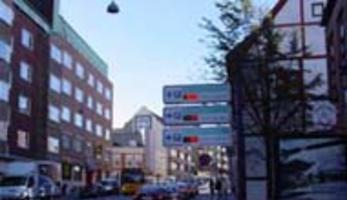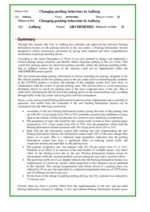Changing parking behaviour (Aalborg)
Thematic areas
Demand & urban space management
Summary
Many cities across Europe are becoming more and more congested with cars, which degrades the quality of the urban environment and takes its toll on people’s health and wellbeing. Aalborg wants to decrease the number of cars in certain areas through a revised parking system.
Implementing sustainable mobility
Through this measure the City of Aalborg has extended and improved the real-time Parking Information System on the parking network in the city centre. A Parking Information System designed to reduce unnecessary circulation by giving more targeted and more comprehensive information to parking searching drivers. The main objectives of the measure are to:
- Reduce car traffic in certain areas;
- Enhance accessibility to the city centre and the commercial area on the outskirts of the city; and
- Achieve a modal shift away from the private car towards public transport, walking and cycling.
The current parking guidance system dates from the mid-1990s. It needs a thorough review, especially bearing in mind the re-development of the waterfront in the coming years where parking demand is predicted to rise dramatically.
Progress
According to the initial Description of Work it was also planned to design and implement a revised parking charge structure, and thereby reduce long-time parking in the city centre. This would free parking spaces for short-term parking and thus reduce the parking-searching traffic. Due to political reasons this part of the measure could not be implemented within the ARCHIMEDES project period.
The old system providing parking information to drivers searching for parking, designed in the 90s, did not include all the new parking areas in the city centre and was technologically outdated. In the CIVITAS project a revision and redesign of the complete system have been done, in collaboration with the owners of private parking areas. The aim has been to avoid unnecessary kilometres driven in search for parking areas in the most congested areas of the city. This is achieved by informing the drivers about free parking spaces in the closest parking areas, avoiding through traffic in the city centre and saving time and fuel consumption.
Outcomes
Hence, a new and up-scaled Parking Information System has been implemented and is currently in operation. The results from the evaluation of the new Parking Information System can be summarised into the following conclusions:
- Awareness of the new Parking Information System among the users of the parking went up with 18% (14 pct point) from 78% to 92%, probably caused by the installation of more signs in the scheme, and the fact that the new system is more intuitively to understand.
- The proportion of users who found the new system made it easier to find a parking space increased by 27% (17pct. point) from 62% to 79%. Also the proportion, which used the Parking Information System increased with 34% (8 pct point) from 23% to 31%.
- Both with the old information system still working and after implementing the new Parking Information System, the information system made 18% of the users change their choice of car park. This is a relatively large proportion, indication that the parking Information system does have a significant effect on reducing search traffic and congestion around, and especially in, the parking areas.
- The parking occupation rate was reduced with 1/3 (20 pct point) from 61 to 41%. Primarily as an effect of an increase in the total number of available spaces. Any direct effect on the Parking Level due to the new Parking Information System cannot be documented, while the assessed usability and use among the users show a positive effect.
- The peak hour traffic level was slightly reduced after the Parking Information System was implemented. It is however, unclear which proportion of this reduction can be attributed to this measure. The average transportation time before arrival to a parking place was reduced by 19 sec per trip equivalent to a reduced transportation time-use of 9,978 hours and 233,000 less km driven per year.
- On the basis of the change in parking seeking driving, the CO2 emission was reduced by 71 tons per year.
Overall, there has been a positive effect from the implementation of the new and up-scaled Parking Information System in Aalborg. A new and coherent Parking Information System seems to have a positive effect on the parking-searching traffic flow in midsize cities. However, the following lessons learnt might be useful for other road authorities:








